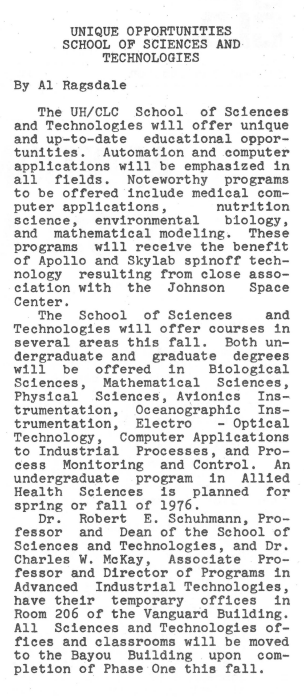Retrospection: UHCL’s STEM history stems back to the 1970s

In July 1975, the as-yet-named student publication, that would later become The Signal, published its second issue with a featured article by Al Ragsdale on the launching of the School of Sciences and Technologies at the University of Houston-Clear Lake (UHCL), formerly known as the University of Houston at Clear Lake City (UH/CLC).
Ragsdale’s article described the future programs as “unique and up-to-date educational opportunities.”
Working closely with the National Aeronautics and Space Administration’s (NASA) Johnson Space Center, the school offered classes on automation, computer applications, medical computer applications, nutrition science, environmental biology, and mathematical modeling. The engineering and science programs were supported by Apollo and Skylab technologies in association with the Johnson Space Center.
UHCL offered graduate and undergraduate courses that would count towards degrees in Biological Sciences, Mathematical Sciences, Physical Sciences, Avionics Instrumentation, Oceanographic Instrumentation, Electro-Optical Technology, Computer Applications to Industrial Processes, Process Monitoring and Control, as well as an undergraduate program in Allied Health Sciences.
UHCL faculty charter members Robert E. Schuhmann, the school’s dean, and Charles W. McKay, director of programs in Advanced Industrial Technologies, led the school in close collaboration with NASA and Johnson Space Center to make UHCL a hub for Science, Technology, Engineering and Math (STEM). The school was scheduled to launch for the fall 1975 semester. Schuhmann retired from UHCL in 1989 and passed away in May 2015. McKay served as Dean from 1995 to 2006 before retiring. McKay now serves as Chairman of the Board of Directors for Teaching Systems, Inc.

The College of Science and Engineering (CSE), as it is now known, is still renown for its STEM programs. The school offers 24 undergraduate degrees and 35 graduate degrees, as well as minors ranging from Actuarial Science to Cybersecurity, certificates in Biotechnology, Physics Candidacy, Software Engineering and Systems Engineering.
In March 2017, UHCL broke ground on a new STEM facility set to open fall 2018. The $65.7 million dollar building is set to take advantage of the school’s adjacency to local offices for Boeing, Lockheed Martin and SpaceX, as well as continue to work closely with NASA’s Johnson Space Center.
CSE continues to foster STEM growth within and beyond the confines of UHCL, with ongoing semester events and seminars focused on issues in STEM. The school also partnered with San Jacinto College to form the Bridges to STEM Careers (BSC) program in 2014. The BSC program hosts an annual STEM challenge, which saw 32 teams of 127 students from colleges and high schools compete April 8.
With the rise of female enrollment in STEM-related programs, the arrival of the Morpheus lander at to Space Center Houston, as well as Houston’s latest partnership with Microsoft, the Space City’s STEM society continues to grow exponentially, with UHCL poised to partake closely with the progress ahead.
Also published on Medium.

